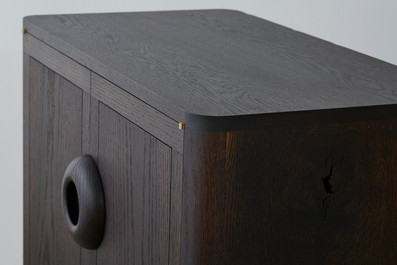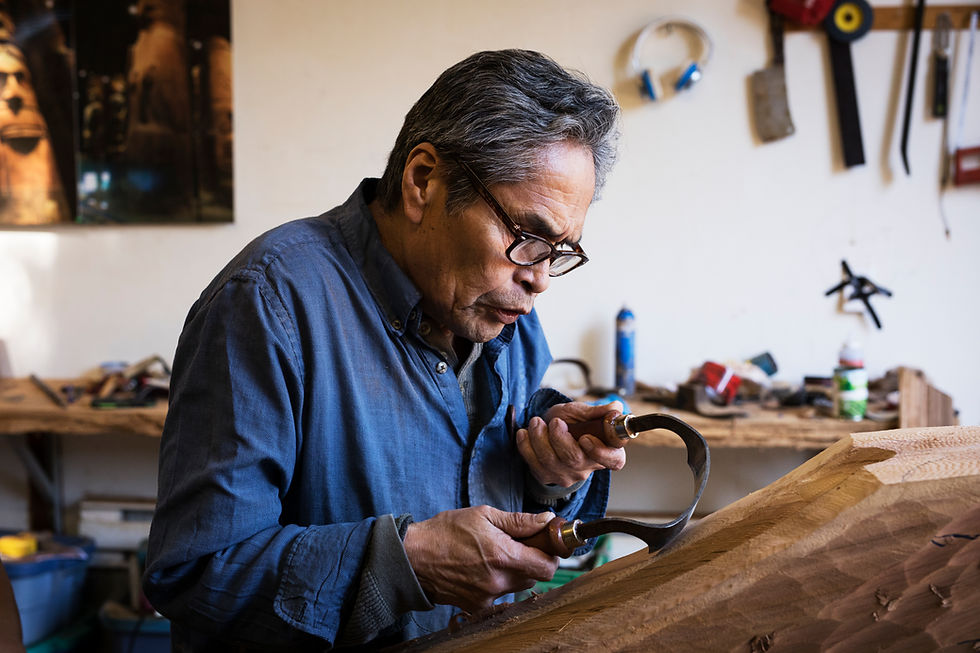Daniel Gruetter (Web Exclusive)
- Ornamentum
- 6 days ago
- 5 min read
Updated: 4 days ago
Medium/Technique: Woodworking, furniture design
Location: Toronto, Ontario
Website: https://www.danielgruetter.com/
Social Media: https://www.instagram.com/danielgruetter/

1. How would you describe your art and artistic practice?
My practice is how I process and engage with the world around me. It’s a demonstration of my ideals and my worldview. I see it within a historical framework, as part of a larger system with cultural and social functions and responsibilities.
My works sit at an intersection of craft, art, and design. On one hand, it is based on wood and material expression. It exists as functional objects and furniture. And it’s conceptual, engaging with economics, historical and ideological topics.
2. How did you first get into woodworking and furniture design?
I grew up in a remote community called Bella Coola on British Columbia’s Central Coast. My parents built their own house and I was surrounded by builders and artists of all kinds. Making has always been immersive and intuitive for me, from drawing and painting in my youth, to construction and renovations, ceramics and silkscreen as a young adult.
I didn’t learn woodworking and furniture making until I moved to Toronto, where I found work with furniture and design build companies. Eventually I started renting space at woodworking co-operatives, where I’ve learned from many artists, designers, and makers over the years.

3. Where do you find inspiration for your work?
The primary inspiration for my work is the natural world. Trees are a wonder in their infinite variety and disparate capacities. You’ve heard the idea that drawing is a form of observation? I think craft is an observation of material properties. I believe craft is not just the process of making or the object that results, but a type of listening, a relationship with the natural world. This way of being is a counterpoint to modern life, a reorienting, and a going home for me. It is both inspiration and motivation for my work.
4. Can you walk us through your creative process, from initial idea to sourcing materials to the physical act of making?
I think of each work as an essay, where all the choices, materials, forms, treatments, and processes contribute to the meaning of the whole. I try to create focus around a type of wood, a specific quality, treatment or technique.
Often, I generate numerous iterations of an idea, first in pencil drawings, then digital models, and prototypes. I source material from a variety of lumber suppliers, including local mills, salvaged lumber suppliers, sometimes arborists, or even foraged from the forest.
Making really depends on the project as the process is an important part of the meaning of the work. Most of the time the process from start to finish has to be methodically planned out as modifications are difficult to make without affecting following processes.
Once a piece of made it always surprises me a little, no matter how much planning I’ve done. It has a presence and it often opens a door to another project, idea, or iteration.
5. During the 2025 CSDA Symposium, you shared your insights on what it means to be a “modern maker” working in a field that’s rooted in longstanding craft traditions. Do you feel it’s important to honour those traditions in your work, or are you interested in breaking the mold of what came before you?
Craft is a process, both in terms of an individual’s path in making, and also as a cultural process. I believe craft must be relevant to the times. In some cases, that means preserving or reviving a particular method, and in others, it means adapting or changing a process. For example, Japanese designer Oji Masanori designs contemporary, saleable products and works with traditional craftspeople to produce the pieces. His work helps preserve the craft and skill while making it relevant to the modern market.
Patchwork coffee table, 2025, salvaged structural timbers including Douglas fir, Pseudotsuga menziesii, Eastern white pine, Pinus strobus, Aromatic cedar, Juniperus virginiana, brass, oil-varnish. Photos by Lindsay Rosset.
6. In your “Patchwork” series, you use salvaged offcuts to create finished pieces. How does this aspect of upcycling or repurposing materials that some might consider “waste,” shape your practice?
As a designer and maker I believe my role in society is to add value to raw materials, inform how resources are managed, and produce a cultural product. More than physical products, making has cultural value too.
The ‘Patchwork’ series is a demonstration of the potential of craft to transform waste material into something of value. In one piece I use oak off-cuts collected from my workshop. Knots, cracks, discolourations, become beautiful features in a composition. In another I use salvaged dimensional softwood lumber from a deconstructed house. It’s full of nail holes, electrical wire holes, stains, etc.
This reframing of defects and waste is central to my work. Making the most with the least. Adding value. It’s a demonstration of a way to value material alternative to industrialized extraction and production.

7. Tell us about a favourite piece or collection you’ve created and why it’s so memorable.
I consider a piece successful if it tells a truth well. It can be subtle, but the work should give focus to something specific about the material, its place of origin, its relation to us.
For example, a piece that feels really good in your hand does so because it makes good use of the smoothness and warmth of the hardwood it’s made of. It not only presents a specific characteristic of the material, but invites an intimate relationship with it. My series of turned vessels based on the fruiting bodies of local hardwoods are good examples of this.
8. What have you encountered in your career so far that readers (or other artists/makers) might find surprising or unexpected?
I don’t know if readers will find this surprising, but I’m often surprised how my work is received. I find it surprising how a given context changes the conversation about the work. For example, when an object or piece of furniture is in a design show, versus a craft market, or art gallery, it is seen differently, valued differently. There are different expectations and allowances given.
Clockwise from top left: Cabinet in oxidized red oak, 2022, Red oak, Quercus rubra, sassafras, Sassafras albidum, brass, oil-varnish // Table with live edge, 2021, white oak, Quercus alba, moose antler, oil-varnish // Turner's stool, 2025, oxidized black cherry, Prunus serotina, oil-varnish // Cabinet in Douglas Fir (detail), 2024, salvaged Douglas fir timbers, Pseudotsuga menziesii, brass, oil-varnish // Credenza in black walnut, 2022, black walnut, Juglans nigra, soft maple, Acer sp., oil-varnish. Photos by Lindsay Rosset.
9. In what ways do you hope your own practice continues to evolve?
I hope to keep learning about local materials, their properties and histories, and to use that knowledge to make work that shows a path towards environmental and economic justice. I hope to collaborate with like-minded people to build a shared future based on egalitarian ideals, and rooted in the land that we live in.
10. Pay it forward -- tell us about something or someone our readers should know about.
Cry Rock, a beautiful and insightful film from Bella Coola, by Banchi Hanuse about the Nuxalk language and culture and their inseparability to the land.
A recording of Daniel speaking at the Ornamentum Spotlights Modern Makers panel during the CSDA/CCAD 43rd Annual Symposium is available exclusively on our CSDA/CCAD Member Portal. Not a member? Join now to access this and other benefits!




















Comments